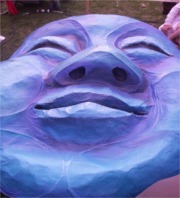The Magic of May Day
Maria Montello
APRIL 25, 2008

- Brilliantly colored puppets, the mark of May Day
- (Maria Montello)
Be they toddlers or grandparents, loyalists or neophytes, socialists or pagans, everyone seems to come out of hibernation in the Twin Cities to celebrate May Day. The largest of its kind in the United States, this celebration has been the harbinger of spring every year in Minneapolis since 1974 with a community-created parade and ceremony.
What is May Day? The tradition of May Day goes back to pre-Christian times when the Celts ushered in summer with rites of purification. They hoped those would bring good luck and a fruitful harvest next season. They conducted rituals to protect from the spirits of the Otherworld thought to be near during this transition time. They lit bonfires. They hung boughs. They partied.
That the sun is at its halfway point between the vernal equinox and summer solstice is likely of little concern to this year's May Day parade goers. We have no herds to let into the fields. And a good deal more than a bonfire is needed to ward off the demons of our day.
Nonetheless, organizers of the parade and ceremony, wholly a creation of In the Heart of the Beast Puppet and Mask Theater, are true to the spirit of the day. Sandy Spieler, artistic director and 34-year veteran, explains to the children who come to the parade prep workshops that this year's theme, "A New Bridge", asks us to consider: "What are the systems that we are building that help people? Are we thinking about how we are supporting each other through difficult times?"
She relays the themes from community planning meetings which identified today's demons: violence in our streets and in our world as well as the crises in housing, health care, education and the environment. While the parade's first chapter "Racing Toward Collapse" begins with these themes, it moves toward celebration of what is happening today to address these issues. The story then prods us to think to the future, how through our efforts and wisdom we can flourish as a community.
Hearkening back to the collapse of the 35W bridge in Minneapolis, Spieler relates the comments of Hamdy El-Sawaf of the Islamic Jurisprudence Council of Minnesota at the memorial service for the thirteen who lost their lives: "If a bridge made of iron, steel and concrete can fall down, then a human bridge of faith, trust, confidence, and hope must be established."
On the outside, what distinguishes this parade is certainly the massive, brightly-colored puppets, the diversity of its participants and onlookers and the absence of corporate-sponsored floats. However, the true magic is in the making of the day -- the hundreds of kids and adults, staff and volunteers who build everything that makes up the parade. Brilliantly orchestrated pandemonium, the workshops bring together yogurt containers and kids, paint and parents, old boxes and art students, to create something truly enchanting.
Watching this process, it became clear that the message of the day, the building of bridges, was already happening. And it will have happened long before the music begins.
This year the May Day parade is on Sunday, May 4 at 1 PM in Powderhorn Park in Minneapolis, Minnesota.




